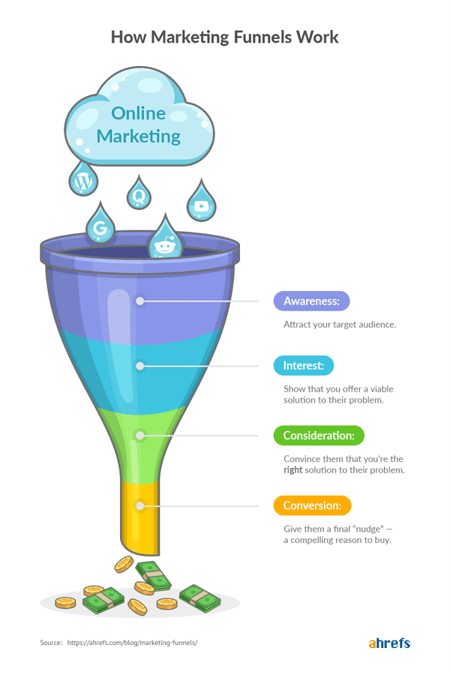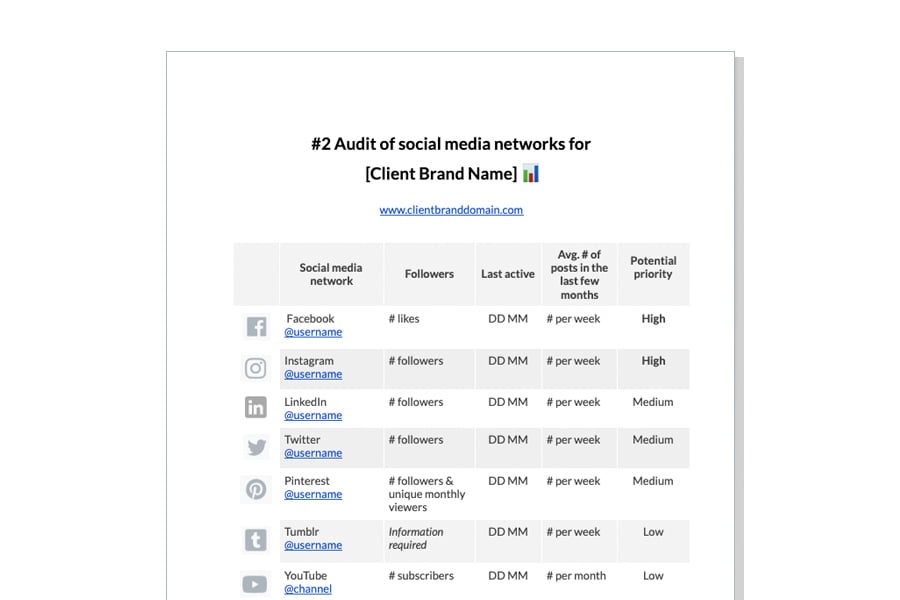Sendible insights Close More Clients With an Effective Social Media Proposal [Template]
Growing your agency means you need to attract and win more clients.
And part of that process involves creating and presenting proposals to prospects.
But what exactly goes into an effective social media proposal? And how do you qualify a client beforehand?
In this article, you’ll learn how to run a discovery session and create a social media marketing proposal, so that you can present your ideas to potential clients and generate more business.
Feel free to steal our social media proposal template! It's a fully customisable Google Doc, so you can easily adjust it to fit each of your clients and the type of services you'd like to offer 🎁.
What is a social media proposal?

A social media proposal is a document that you present to your prospective client outlining how you can help them achieve their goals.
Whether you're a social media marketing agency, a PR firm or an advertising agency, a service proposal is an essential part of your client acquisition toolkit.
It's not a pitch and is created after a consultation and thorough research into what your potential client needs.
This is how the process usually goes:
- Have a consultation or discovery call with the prospect
- Research the client and their industry
- Send the proposal with services and pricing
- Discuss the offer and adjust if necessary
- Sign the contract and start the project
Your potential clients need to know what you can do for them and their business, and a proposal is a medium for you to convey your message.
When is the best time to send your social media marketing proposal? ⏰
In marketing and sales terms, a proposal is used in the conversion stage of the funnel. At this stage, the prospective client is aware of your agency and is considering using your services. The proposal forms part of the final push to convince them that you’re the best option.
The strongest proposals are goal-driven, concise, and, most importantly, speak directly to the pain points of your prospect and how you could help solve them.

Image source: Ahrefs blog on marketing funnels
What you'll need to know before writing your social media proposal?
Before you can write a proposal, you need to understand what your potential client needs:
❔ What do they expect to gain from social media as a marketing channel?
❔ Which audiences and channels make the most sense to tackle now?
❔ And how can you help them?
The best way to find out is to hold a ‘discovery session’.
Ideally, you should either have a face-to-face meeting or a video conference call. Putting a face to a name at this stage helps humanize the process and builds a relationship. Plus, it saves time pinging emails back and forth.
The goal of a discovery session is to ask questions and listen to what your potential client has to say. Aim to find out:
- Their current challenges.
- Their overall goals and what they hope to achieve.
- The state of their social media marketing (e.g. what’s worked and hasn’t worked so far).
It’s also important to remember that a discovery session helps you decide if you’re a good fit. For example, you may find out your potential client wants a service you don’t provide or doesn’t have the required budget for your services.
In marketing terms, the discovery session qualifies your lead as a definite prospect. Or, disqualifies them and helps you avoid wasting time on creating a proposal that will most likely get declined anyway.
Our must-ask discovery session questions to create a detailed proposal 💬
Here are some discovery session questions to consider asking your prospective client - feel free to adjust them as needed!
#1 Ask about business and marketing goals
Start with an overview of their current business and marketing plans:
❔ What are your current goals for your business and how do these align with your marketing goals for social media?
Your client's overarching business goal will always be to increase their customers base, so you could look to the networks most suitable to their audience and set out clear KPIs for them. For example:
- Facebook goal: increase visits or orders for the online shop.
- Instagram goal: increase profile visits, inquiries, and direct messages.
- Twitter goal: increase website visits and direct messages.
- LinkedIn goal: increase website visits.
- The overall goal for marketing activities: increase leads and conversions.
However, if they're just getting started, it would be unrealistic to expect social media channels to drive brand awareness and leads at the same time. In that case, you'd want to focus on growing an audience and engagement instead.
Next, you'll need to evaluate what they’ve tried to date and find out what’s worked and what hasn’t:
❔ What areas are overperforming and underperforming?
❔ What does success look like for you?
❔ Where would you like to be in 12 months? Describe the ideal but realistic situation to me.
#2 Get granular about their target audience
Find out your potential client's marketing personas, so you can propose the right goals and social networks to focus on.
Then, dig deeper and ask them about their best (or worst) customers and what motivates them. By understanding the pain points and relief customers experience, you'll be able to come up with even more creative content ideas for all social media channels.
Determine their target audience with this four-category approach:
- Socio-Demographic: age, gender, occupation, family size, etc.
- Geographic: do they live in the city or the countryside, are they part of a large community, etc.
- Psychographic: what are their values, how do they spend their free time, what are their favorite activities, etc.
- Behavioral patterns: what are their shopping behaviors, how often do they go out, traveling patterns, hobbies, etc.
#3 Figure out their main competitors
Next, determine their business competitors. It might be a local business like another restaurant or an international brand. Ask questions like:
❔ Who is your main competition?
❔ What social media networks do they use?
❔ Are there any types of content they create that you'd also like to see on your social media channels?
This is also a good time to set the expectation that most global brands have huge advertising budgets and large content teams. While it's good to aspire for their greatness, business owners need to be realistic and remember to focus on what will help them grow.
#4 Get clarity on their scope and budget
Finally, find out what they need help with and how much they’re prepared to invest. This could range from a single campaign or upskilling their team to a fully managed, monthly retainer service.
Ask questions that will help you understand their budget:
❔ What are your goals for this project?
❔ How soon would you like to start?
❔ What is your allocated budget for this project?
The more you know about the value you can provide to the business and what their budget is, the easier it will become to negotiate a good rate for your social media services.
#5 Be open and flexible
Each prospective client is different. The size of the business and their experience with social media marketing will vary just as much as their needs and budget availability.
For instance, they might be a brand new company with no previous history or experience. In which case, they'll most likely need a package that's inexpensive while focusing on all key aspects of audience building on one or two platforms.
On the other side of the spectrum, the brand might be well-established and be needing to switch up its strategy on several social networks and introduce more video content.
That’s why hosting a discovery session is vital before you create your social media proposal. Especially, if you want the highest chance of winning new business!
What to include in your social media marketing proposal?

Your proposal needs to demonstrate an understanding of the prospective client’s requirements and how you are best equipped to fulfil them.
We go through the process of creating your own template below, but you're most welcome to download our free and customisable social media proposal (it's in Google Docs format).
Your document needs to address the following questions:
- What are you going to do?
- How are you going to do it?
- Who’s going to do the work? Which of your team members will be working on the account?
- How do these activities benefit your prospective client? How is their business going to be transformed as a result of working with you?
- How much is this going to cost?
Here's how you can incorporate these answers in your proposal for social media marketing services:
1. Introduction
The opening paragraphs set the scene for your proposal based on the discovery session you held previously. You want to set your prospective client’s expectations and show you understand what they require.
Use words like you, yours and we to address the prospective customer directly and establish a relationship. For example:
Hi Ellie,
We’re delighted you’ve asked us to show you how we can help grow your audience and acquire more leads with our social media skills.
This proposal outlines precisely how we can use our proven expertise and strategies to deliver effective, growth-driven results for your business.
Please review this document and let us know if you have any questions. If you'd like to work with us, the next steps after the review are to choose your package and finalise the contract terms.
Next, you can go into a little more detail matching their business goals to social media goals and objectives.
Try to avoid giving generic descriptions of the services you'd like to provide, and instead focus on measurable objectives or SMART goals.
For example, if the prospective client indicated they wanted to grow their target audience of young consumers, you could say set this SMART goal:
🎯 SMART goal example: Increase the number of Instagram followers in the age range 25-34 by 20% over the next six months.
For smaller brands, it could be more pertinent to focus on growing their audience. In which case, try tying the broader goal with the number of posts you'll be publishing for the client:
🎯 Output-based example: Grow the total audience of the brand by 15% by posting consistently on all 3 social media accounts.
2. Scope of work
Here’s where you state what activities you’re going to perform for your prospective client. It’s worth adding why you’re proposing to do each item, so they understand the reason behind it.
If you're planning to offer different types of packages, it's worth clearly highlighting what will be included in each package at the end of the proposal.
It’s useful to break this section into subsections, so it’s clear for everyone. Typical subheadings in a social media proposal include:
- Content creation and curation: Highlight your main responsibilities like creating a social media content calendar, designing images, taking bespoke photographs, recording videos, writing captions, and curating industry-related content. Note: You can also outline the steps of the approval process in this section to help clients see at which point they need to get involved.
- Platform selection: Outline why you’ve chosen specific social networks. For example, they may be more suited to the target audience or their competitors are active there.
- Posting schedule: State how often you'd propose posting to each network and why. For example, we’ll post once a day to Instagram using different types of content (including visual content creation and captions) to build traction on your account.
- Brand monitoring: Advise which are some of the brand keywords and hashtags you could be tracking.
- Engagement and community: Advise how often you’ll be engaging with followers. For example, a set amount of time each day or reply to engagements within a set number of hours.
- Timelines and milestones: Used for specific campaigns; e.g. holiday promotions, in addition to the regular posting schedule.
- Analytics and reporting: Include the frequency of the reports and details of what you’ll be tracking and why.
- Review meetings: Schedule regular catch-ups to review overall performance and exchange ideas.
- Working arrangements: If applicable, include a section stating where and who will do the work. For example, will this work be done remotely or in the prospective client’s office?
For larger accounts, you might also want to nominate individuals who’ll be involved. For example, the lead copywriter, designer, and project or account manager.
If your agency has a large range of services, you can also mention what’s not included in the proposal or set packages but can be purchased as an add-on.
Add-on example 💰: Content creation excludes creating Facebook ads management but it's available as an additional service upon request.
3. Project milestones and deadlines
Use this section to define how you’ll measure the project’s success. Don’t forget to benchmark current performance levels so you can measure the growth.
For example: Increase Instagram Engagement Ratios over the next 6 months. To get this data, use Instagram Insights and social media analytics tools like Sendible to measure engagement ratios; e.g. reaching and interacting with more followers per month.
4. Proof of work
It’s highly likely that your prospective client will review several proposals. So aside from explaining what you plan to do, you should show why you’re the best option.
Clients who’re looking for a marketing agency need to be convinced that the agencies they’re looking to hire are trustworthy, and will deliver a return on their investment (ROI).
An excellent way to show your value is to use results, case studies, and testimonials from other clients. The key is to select examples from your marketing portfolio that closely match your proposal. The more relevant they are, the stronger your case becomes. Here's an example:
When we started working with ABC Company, they had 300 followers on Instagram. Over the next six months, we were able to increase that number to 1500 by posting regular content, replying to comments, and sharing user-generated content.
5. Terms of the agreement
Use this section to propose your fees and payment terms.
Fees: Depending on the scope of the work there may be several components including a fixed project or an hourly or monthly retainer.
If there are several options, list them clearly. Tables usually work well here as you can itemise project activities.
Payment: Specify how you invoice and what your payment terms are.
Termination: Include how either party may end the agreement.
6. Next steps for the client
Draw your proposal to a conclusion by outlining the next steps for the client in the process. For example, you might include:
- Accept the proposal as-is or discuss changes
- Request and sign the contract
- Submit an initial payment
Delivering your proposal

Once you’ve completed your proposal, proofread it or ask a colleague to double-check it.
When it comes to presenting it, you have a few options.
- If possible, arrange to present the proposal in person or via a video call so you can walk your prospective client through each section. Doing it this way allows you to address any immediate questions or objections.
- Alternatively, send your proposal via email. But make sure you add an expected reply date so that you’re not left hanging.
Borrow our effective (and free!) social media proposal template 🎁
Now that you know what goes into creating a winning social media proposal, it's time to implement all that knowledge!
Create yours from scratch OR use our free Google Docs template to save time (which as you know = money).
The best part is, you can make a copy of the proposal template and edit it, and then reuse it as many times as you like!
Plus, there's plenty of additional guidance to help you personalise your offer, including a one-page social media channel audit you can carry out on your client's accounts and optional add-ons you may want to charge extra for in the future.
As with all templates, remember to personalise your proposal as much as possible and add images where applicable. It's so important to be authentic and build trust with your future clients!
Wrapping up
Creating a social media marketing proposal for prospective clients is an essential part of winning more business and growing your agency.
Ultimately, the more detailed and tailored you can make your proposal for each prospective client, the higher the chance of closing your next deal! One way to make it so is to host an in-depth discovery session prior to crafting it.
Use templates whenever possible. They'll help you save time, be more effective, and avoid missing anything important.
Text copied!


